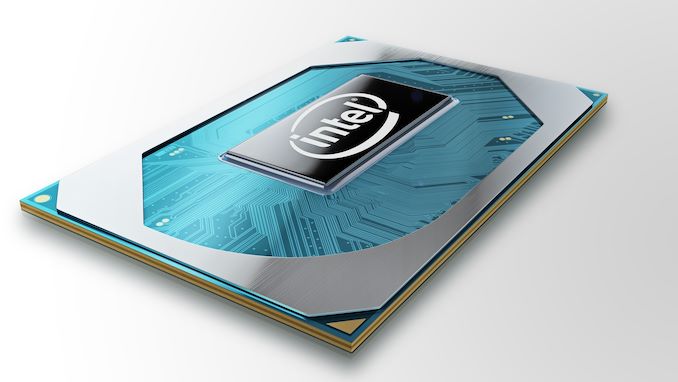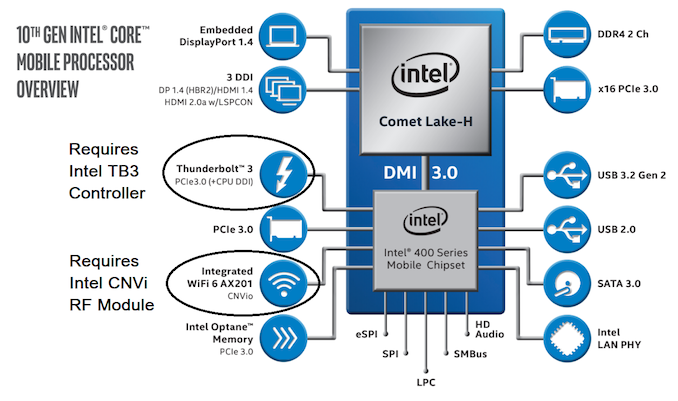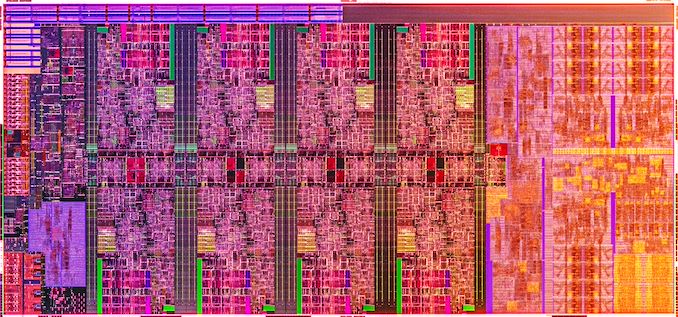Intel Details 10th Gen Comet Lake-H for 45 W Notebooks: Up to 5.3 GHz*
by Dr. Ian Cutress on April 2, 2020 3:01 AM EST
Two of the big announcements out of CES this year were both mobile related: Intel and AMD announced they would be launching new gaming laptop processors into the market in the first half of this year. 45 W parts, also known as H-series in the business, provide the basis for productivity and gaming notebooks that use additional graphics to give some oomph. These systems span from thin and light with GPU requirements, through ‘luggables’ that are just about portable, all the way up to desktop replacement designs. Intel’s newest 10th Gen H-Series are based on the Comet Lake family, the fifth iteration of Intel’s 14nm Skylake designs, and they’re going all the way up to 5.3 GHz*.
The new CPU list from Intel starts with the Core i9-10980HK at the top, with eight cores, sixteen threads, and all the focus is on that 5.3 GHz turbo frequency.
*This CPU can hit this frequency on two cores. However this has some specific requirements: the system needs to be within its secondary power limits, and Intel’s Thermal Velocity Boost also needs to be turned on. The latter of which means that there has to be additional thermal headroom in the system, and that OEMs have designed for this and enabled it within the system. This allows the CPU to go from 5.1 GHz to 5.3 GHz. Every Intel Thermal Velocity Boost enabled CPU requires specific OEM support in order to get those extra two bins on the single core frequency.
The base frequency of this chip is 2.4 GHz, and it has a regular 45 W TDP (sustained power), which can be run in cTDP up mode for 65 W. Two other plus points on this chip is that it is unlocked, for when an OEM provides more thermal headroom, and it supports DDR4-2933, which is an upgrade over the previous generation. Intel's recommended PL2 (turbo power) for the Core i9 is 135 W, and Intel says the recommended 'Tau' is set to 56 seconds for the i9, and 28 seconds for all the other CPUs. OEMs don't often adhere to these values for notebooks, but they are provided as a guide. It does mean that in order to hit 5.3 GHz, the Core i9 is by default allowed to take 135 W across two cores, or 67.5 W per core. Even at 60W per core, you're looking at 50A of current per core... in a laptop.
| Intel 10th Gen Core 45W Processors (Comet Lake-H) |
|||||||
| AnandTech | Cores Threads |
Base Freq |
Turbo Freq*1 |
Turbo Freq*2 |
DDR4 | TDP | cTDP Up |
| i9-10980HK ++ | 8 / 16 | 2.4 | 5.1 | 5.3 | 2933 | 45 W | 65 W |
| i7-10875H | 8 / 16 | 2.3 | 4.9 | 5.1 | 2933 | 45 W | - |
| i7-10850H + | 6 / 12 | 2.7 | 4.9 | 5.1 | 2933 | 45 W | - |
| i7-10750H | 6 / 12 | 2.6 | 4.8 | 5.0 | 2933 | 45 W | - |
| i5-10400H | 4 / 8 | 2.6 | 4.6 | - | 2933 | 45 W | - |
| i5-10300H | 4 / 8 | 2.5 | 4.5 | - | 2933 | 45 W | - |
| *1 Turbo Frequency for devices without Thermal Velocity Boost *2 Turbo Frequency for devices with Turbo Max 3.0 and Thermal Velocity Boost ++ Unlocked CPU + Partial Unlock |
|||||||
Intel only has a single Core i9 at the top, with the top grade i7 also getting 8 cores, but only up to 5.1 GHz and no overclocking. The Core i7-10850H is going to be the second exciting part over the i9, with six cores and a 5.1 GHz turbo, but it allows an additional 4-bin overclock on the first two cores where thermals allow. All of the CPUs here are listed as 45 W, and all support DDR4-2933 memory (up to 128 GB we believe). Due to Intel Thermal Velocity Boost, all the i7 and i9 parts are +200 MHz above what they would be without the technology, with frequencies that we are more used to seeing on the 9th Generation.
Intel states that there will be 30+ designs using the new 10th Gen Comet Lake-H that fit within the ‘thin and light’ profile of 20mm, and 100+ designs in total across consumer, commercial and workstation. Intel is keen to highlight that it is the only CPU vendor that has OEM partners that provide HDR1000 panels and 300 Hz refresh displays in this market.
Intel also made a big fuss about TB3 support, although it isn’t native here – you still require a controller. One positive for 10th Gen is that it supports two TB3 controllers, rather than previous generations that only supported one. Though again, it depends on whether the OEM puts it in their system, because it isn’t native to the CPU.
We’re not going to post Intel’s benchmarks here, because to be quite honest they are not comparable. In gaming tests, Intel compares a 10980HK equipped with a RTX 2080 Super to a 7820HK equipped with a GTX 1080. As a result, a lot of difference in the gaming performance is going to be in the GPU, but also the graphs that they showed did not start at zero – suggesting that the graph somehow doubled despite only rising 44% in a select test. We’re going to wait to see for ourselves what the hardware can do.
Intel did show a die shot of the silicon, with all of its eight cores. It looks strikingly similar to the Coffee Lake 8-core silicon, because it’s practically identical. If there are any changes, it is minor, and then the chip is binned for the voltage profile.
Meanwhile, although none of Intel’s partners were named or otherwise involved in Intel's own announcement, they have been holding separate briefings regarding their laptop plans. MSI, Lenovo, Acer, and others are all releasing 10th Gen laptops as soon as April 15th, with the rest to follow in May. Broadly speaking, expect to see many vendors update existing 9th Gen gaming systems to include 10th Generation parts, though in the case of gaming laptops we're going to see the occasional, more substantial update to take advantage of NVIDIA's new hardware and thermal capabilities.
Intel’s competition here is going to be the recently launched Ryzen Mobile 4000 processors, in devices like the ASUS Zephyrus G14 and the Dell G5 SE. These new APUs were launched on 1st April, however unfortunately we were not told of an embargo change, and still expected the launch to be another two weeks later. We’re aiming to get our review out next week. When we get access to Intel’s 10th Gen H-series, we will compare it against AMD as well.














157 Comments
View All Comments
Andriivas - Sunday, November 22, 2020 - link
Hello! I am looking for a laptop with a powerful processor (I plan to do web development). I choose between these processors https://vsrank.com/en/intel-core-i7-7700hq-vs-inte... Is it worth overpaying for Intel Core i7-10750H?29a - Friday, April 3, 2020 - link
I just bought a Ryzen 3 laptop with two cores and it does average computer stuff just fine and boots really fast. $279 for Ryzen 3, 8GB RAM and a 128GB SSD, cant beat it.speedyxvn - Tuesday, April 14, 2020 - link
I have at my parents a desktop with a dinosaur AMD Athlon II X4 620; 6GB of RAM, SSD, and it boots Windows 10 in a bit more than a minute. In your case, I would really check the system, Windows instalation etc.....sharath.naik - Thursday, April 2, 2020 - link
It's all a gimmick. It can go that fast only that it also gets as hot as a desktop class CPU. Which means it never gets to use that boost clock for any practice purpose. Let alone boost 14nm struggles to sustain a constant 40watts even in a Thinkpad chassis. That too after replacing the thermal paste and adding copper pads to move the heat better between the cpu-gpu heatpipes. So best case these can only sustain 3.6ghz for my six core with undervolting. And I for once donot believe that Intel is struggling with 10nm, they are just squeezing 14nm profits as long as they can, fooling people with these 5.3 ghz gimickss.yu - Friday, April 3, 2020 - link
Really? AMD is outselling Intel 5:1 in the desktop space, you'd think that if they've got any tricks up their sleeves they'd have pulled them by now.Namisecond - Saturday, April 4, 2020 - link
Citation plz? I'd like to believe that AMD is beating Intel 5:1 in the desktop space, but if you're going to sling numbers, it benefits your argument if you show the source.s.yu - Monday, April 6, 2020 - link
https://www.notebookcheck.net/Ryzen-5-3600-and-Ryz...This is about 5:1, and unless the data from this particular retailer is somehow severely skewed in AMD's favor, this is the state of the market.
senttoschool - Thursday, April 2, 2020 - link
So literally the exact same CPUs as the last generation but only upped the max Turbo boost which could never be achieved with any normal laptop.Tomatotech - Thursday, April 2, 2020 - link
To be fair, a higher max boost can make a difference in SOME situations. Given a theoretical infinite speed and a tiny cooling capacity, a CPU could complete all work instantly and never overheat because it would instantly return to rest.So postulate a work item that might take a slower cpu 15 seconds at full boost, which then overheats at 10 seconds and throttles down to 50% speed, dragging out the total time to 20 seconds. If the CPU was 30% faster, it could complete the work item within 10 seconds without overheating. 10 secs vs 20 secs, a doubling in perceived speed with only a 30% increase in CPU speed.
Practically speaking, it makes more of a difference for users who's work hovers on that margin of very short very intense use - launching 10 apps at a time, regular autosaving of complex work, switching between heavy duty apps, momentary high demand within apps or browsers etc.
supdawgwtfd - Thursday, April 2, 2020 - link
That extra 30% performance isn't free...It increases heat output by more than the performance gained...
So your example is flawed.